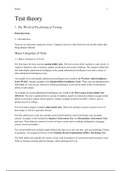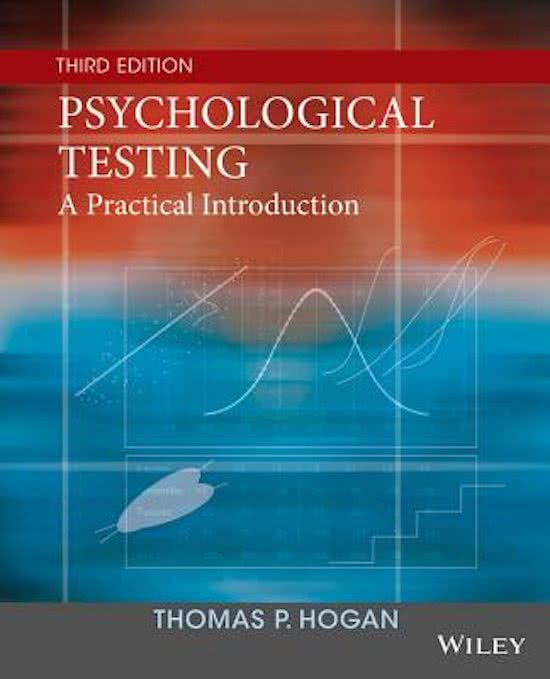Notes 1
Test theory
1. The World of Psychological Testing
Introduction
1.1 Introduction
There are several major categories of tests. Categories however often blend into one another rather than
being sharply different.
Major Categories of Tests
1.2 Major Categories of Tests
The first major division concerns mental ability tests. The term mental ability includes a wide variety of
cognitive functions such as memory, spatial visualization and creative thinking. This category subdivides
into individually administered intelligence tests, group-administered intelligence tests and a variety of
other administered intelligence tests.
An example of an individually administered intelligence test would be the Wechsler Adult Intelligence
Scale (WAIS). Another example is the Stanford-Binet Intelligence Scale. These tests are administered to
individuals in a one-on-one session by trained psychologists to provide an index of the overall mental
ability of individuals.
An example of a group-administered intelligence test would be the Otis Lennon School Ability Test
(OLSAT). This test is administered to a group of students, usually in classroom settings to gauge mental
ability to succeed in typical school subjects. Another example would be the SAT², which is used to
predict success in college.
The next major category includes achievement tests. These tests attempt to assess a person’s level of
knowledge or skill in a particular domain.
The first subdivision in this area includes achievement batteries used in elementary and secondary
schools. Examples of this include the Stanford Achievement Test, the Metropolitan Achievement Tests
and more. These batteries consist of a series of tests in areas such as reading, mathematics, language,
science, and social studies.
The second subdivision includes single-subject tests that cover only one area, such as psychology, French
or geometry. An example of this test is the Graduate Record Examinations (GRE): Psychology Test.
The third subdivision includes the variety of tests used for purposes of certification and licensing in such
fields as nursing, teaching, physical therapy, airline piloting and so on.
,Notes 2
Various government agencies sponsor certain achievement testing programs. Majorly statewide
achievement testing programs in such basic subjects as reading, writing, and mathematics.
The next major category includes the variety of tests designed to yield information about the human
personality.
The first subdivision includes objective personality tests. This means simply that the tests are objectively
scored, based on items answered in a true-false or a similar format. Examples of this include the
Minnesota Multiphasic Personality Inventory (MMPI), the Beck Depression Inventory (BDI) and the
Eating Disorder Inventory (EDI).
The second major subdivision of personality tests include projective techniques. With these techniques
the examinee encounters a relatively simple but unstructured task. The most famous of these techniques is
the Rorschach Inkblot Test.
A third category is labeled ‘’other approaches’’, to cover the myriad of other ways psychologists have
developed to assess the human personality.
The next major category of tests measures interests and attitudes. The most prominent subdivision in this
category includes vocational interest measures. These tests are widely used in high schools and colleges
to help individuals explore jobs relevant to their interests. Examples of such tests are the Strong Interest
Inventory (SII) and the Kuder Career Search ( KCS). This category also includes measures of attitudes
towards topics, groups, and practices.
The final category includes neuropsychological tests. These are tests designed to yield information about
the functioning of the central nervous system, especially the brain. Much of neuropsychological testing
employs ability tests and often uses personality tests too .
1.3 Additional Ways to Categorize Tests
In a performance test, the examinee completes some action such as assembling a product, delivering a
speech, conducting an experiment, or leading a group. However in a paper-and-pencil test, the examinee
responds to a set of questions using pen and paper. Many of these paper-and-pencil tests use
multiple-choice, true-false or similar item types. Computer tests count towards paper-and-pencil tests.
A speed (or speeded) tests purpose is to see how fast the examinee performs. Usually the task is quite
simple. This could be how quickly the participant can cross out all the ‘’e’s’’ on this page, or how many
simple arithmetic problems can the participant solve etc.
A power test, on the other hand, usually involves challenging material administered with no time limit or
a very generous limit. The point of this test is to test the limits of a person’s knowledge or ability (other
than speed). However, the tests aren’t pure speed vs. pure power, oftentimes power tests will have some
,Notes 3
element of speed. However, mental prowess and knowledge rather than speed are the primary
determinants of performance on a power test.
An individual test can be administered to only one individual at a time. The classic examples would be
individually administered intelligence tests. A group test can be administered to many individuals at the
same time, that is, to a group. But individuals also receive their own scores from a group-administered
test. A group test can be administered to one individual at a time, while an individual test cannot be
administered to a group.
Some tests look for maximum performance. This is usually the case with achievement and ability tests.
On the other hand we sometimes want to see a person’s typical performance. For example, on a
personality test we want to know how extroverted a person typically is, not how extroverted he can be if
he’s trying hard to appear extroverted.
Many tests have norms that are based on performance of cases in a standardization program. For example,
your score on the SAT might be in the 84th percentile, meaning that you scored better than 84% of people
in your national norm group. This constitutes a norm-referenced interpretation of your performance on
the test. In contrast, some test interpretation depends on the reference to some clearly defined criterion,
this is a criterion-referenced interpretation.
Uses and Users of Tests
1.4 Uses and Users of Tests
We identify four major groups of users. There is considerable diversity within each group, but each group
is distinct in the way it uses tests. Furthermore, each group uses nearly all kinds of tests, although certain
types of tests predominate within each group.
1. Clinical
2. Educational
3. Personnel
4. Research
The first category includes the field of clinical psychology, counseling, school psychology and
neuropsychology. We label all these applications as clinical use. In these applications the psychologist is
trying to help an individual who has, or may have, some type of problem. This problem may be severe
(e.g Schizophrenia) or mild (e.g choosing a college major). Testing helps to identify the nature and
severity of the problem and perhaps provides some suggestions about a solution. It also may help to
measure progress in dealing with a problem.
This group utilizes intelligence tests, objective personality tests, projective techniques, as well as
neuropsychological tests. Counseling psychologists often use vocational interest measures.
, Notes 4
A second major use of tests in educational settings, apart from the clinical use. We refer here primarily to
use of group-administered tests of ability and achievement. The actual users of the test information
include teachers,, educational administrators, parents, and the general public. Use of standardized testing
in educational settings resolves into two major subdivisions.
First there are achievement tests used for determining levels of student learning. Tens of millions of these
tests are administered annually.
The second primary use of tests in educational settings is to predict success in academic work. A prime
example would be the SAT, which close to two million students take each year.
The third major category of test usage involves personnel o r employment testing. Primary users in this
category are businesses and the military. There are two essential tasks. The first task is to select
individuals most qualified to fill a position. Most qualified usually means ‘’most likely to be successful’’.
The tests may include measures of general mental ability, specific job-related skills and personality
characteristics.
The second task in the employment area has a different opening scenario. In this case there's a group of
individuals who will be employed and we need to assign them to different tasks to optimize the
organization’s overall efficiency. This is commonly used in the military.
The fourth major category of test usage is research. This is the most diverse category. Tests are used in
every conceivable area of research in psychology, education, and other social/behavioural sciences. Tests
often serve as the dependent variable in a research study. Moreover, the test servers as the operational
definition of the dependent variable. Tests are convenient because the researcher does not need to worry
about developing a new measure. Secondly, the existing tests should have known properties such as
normative and reliability information. Furthermore, the use of an existing test helps replicability by other
researchers.
The second major category of research use is for purposes of describing samples. The method section of a
research article provides characteristics described by test information.
The third major category of research usage involves research on the tests themselves. Furthermore, the
development of new tests is itself a major research enterprise. Due to the fact that tests play a prominent
role in the social/behavioural sciences, continuous research on the tests is an important professional
contribution.
Major Issues: Assumptions and Questions
1.5 Major Issues: Assumptions and Questions
A third important aspect of the field of testing is to examine the fundamental issues, assumptions and
questions in the field. Describing basic issues and assumptions helps us understand what the field is all
about.







